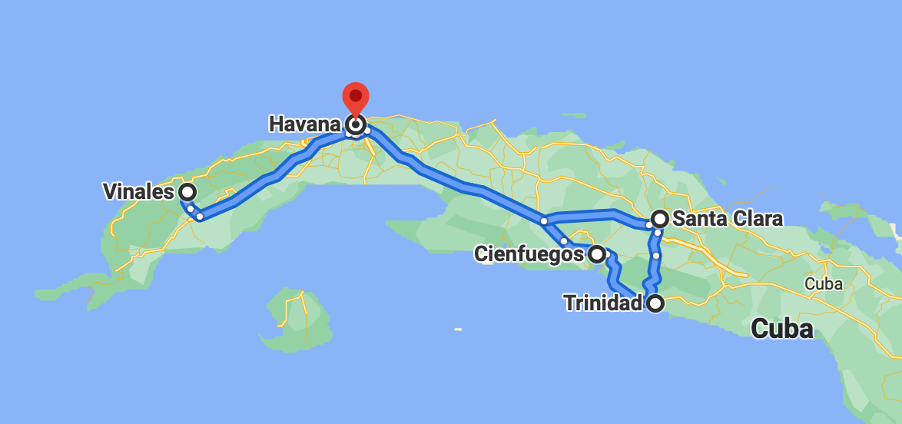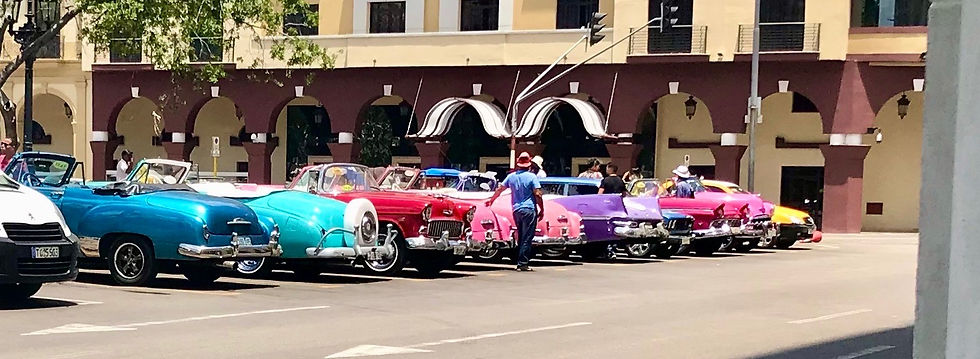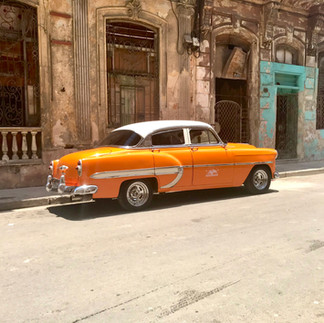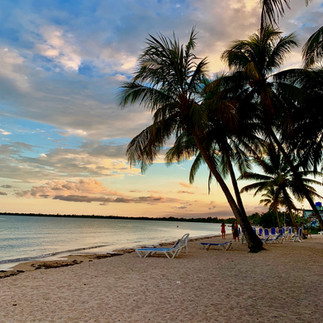Cuban adventure: complete guide to Cuba
- Danielle Hudspith
- Dec 17, 2021
- 6 min read
With beautiful white sand beaches, classic cars and vibrant live music on every corner, visiting Cuba really is like entering another world. It’s a fascinating country with a complicated history, and travelling around the island can sometimes be a challenge. I visited Cuba with my friends on a G Adventures trip in 2019 and it was an eye-opening experience. Be prepared to step out of your comfort zone and immerse yourself in the Cuban way of life to truly understand what makes this country so captivating.
Our itinerary

Getting there
The rules and regulations for getting into Cuba depending on which country you are travelling from. For years, the trade embargo prevented US citizens from visiting the Caribbean Island but recent changes mean travel is allowed under one of twelve authorised categories.
From the UK you just need a valid passport, tourist card and proof of travel insurance.
Getting around
G Adventures is great for organising every aspect of your trip and so we were lucky enough to have our travel and accommodation pre-arranged in Cuba. This mostly involved buses around the country and staying in Cuba’s version of B&Bs, ‘Casa Particulars’.
Where to stay
There are a range of luxury hotels to choose from in Havana, but if you are willing to truly experience what Cuba has to offer, it’s definitely worth visiting a few other places and staying in local casa particulars. These are private houses where hosts rent out a bedroom or two to tourists passing through. Staying in the homes of locals means you save some money at the same time as giving back to the local community. In each casa we stayed in, we had our own room and bathroom and the hosts were friendly and generous, making us breakfast and dinner if we needed it.
Places to go
HAVANA
The first place to start and where the majority of people will fly into. Havana is an intriguing city with crumbling colonial buildings, vintage American cars and beautiful town squares.
The best way to see Havana is definitely on foot. We wandered round Old-Havana or Havana-Vieja which is definitely the prettiest neighbourhood in the city. It is a UNESCO World Heritage Site with colourful old buildings and music playing on every corner. Head to Plaza Vieja or Plaza de Armas for a quick drink or a spot of food, and definitely don’t miss out on a visit to the home of the Daiquiri and Hemingway’s favourite hangout, El Floridita.
We also booked a tour in a vintage convertible car from Parque Central which is an unforgettable way to see the city. We were showed around the classic sights of Havana and enjoyed rolling down the picturesque Malecón in style. The sea wall extends along the length of the city and is a lovely spot to stroll with incredible views of the ocean. If you have a chance to get out of the city, head to the vibrant seaside village of Jaimanitas, or Fusterlandia as it’s better known. Artist José Fuster has turned his home neighbourhood into a masterpiece of intricate mosaic work. It’s free to enter and explore, and local artists display their work for sale so it’s a great place to buy a unique souvenir.
VIÑALES
In contrast to Havana, Viñales is a small town where you will find a slower-paced, more authentic Cuban culture and lifestyle. The area has a rich agricultural history with some of the most beautiful natural landscapes in the country. Viñales is located in the Pinar del Rio region, which grows some of the best tobacco and produces the highest quality Cuban cigars. Visiting a local tobacco farm is an absolute must while you are here. During a tour you will learn about how the leaves are harvested, dried and sorted and then watch and learn how to hand-roll your own cigar, before trying some of the finished product.
Watch the beautiful sunset in the restaurants overlooking Viñales valley and head to one of the bars in the town centre for a bit of spontaneous salsa dancing. You’ll most likely stay in a casa particular which is the perfect way to get a glimpse into the daily home life of the locals. The hosts are welcoming and generous, but it doesn’t hurt to try and learn a few Spanish words to get by in their homes!
CAYO LEVISA ISLAND
The islands around Cuba are particularly beautiful and we were lucky enough to visit Cayo Levisa, with its 3 kilometres of idyllic white sand unspoilt beach.

PLAYA LARGA
Playa Larga is a small fishing village located in the Bay of Pigs that boasts a beautiful and very quiet beach. From here, if you head down the coastal road halfway between Playa Larga and Playa Girón, you can snorkel or dive in the crystal-clear turquoise waters. If swimming in the sea is not for you, just a few meters inland is a small but deep cenote called Cueva de los Peces. This cenote is a natural swimming pool that gives direct access to the deepest cave in Cuba, resulting from long-term tectonic motion. Close by is the Museo Girón which is a small museum that gives the Cuban perspective on the famously failed US invasion in 1961. Beware that the museum does not currently offer any English translation for its exhibits.
CIENFUEGOS
Cienfuegos is known as Cuba’s ‘Pearl of the South’ and is a rare gem of a town that feels quite different to the rest of the country. It has a unique charm with scenic cobblestone streets and picturesque French colonial architecture. From Parque José Martí, we headed up the wrought-iron staircase to the tower of Museo de las Artes Palacio Ferrer for a beautiful view over the city and across the water.
TRINIDAD
It’s definitely worth spending a few nights in Trinidad as Cuba’s best preserved colonial city with its vibrant squares and warm and friendly atmosphere, giving it a unique charm. While you are here, head to Topes de Collantes nature reserve for a hike up to the beautiful Salto de Javira Waterfall. If the cold fresh water isn’t for you then jump in a taxi for a short ride to Playa Ancon, a stunning white sand beach with turquoise water and the tastiest Piña Coladas on the planet.
Trinidad is alive and buzzing in the evenings with plenty of bars and restaurants. Head to Plaza Mayor, the city’s main square and just off here you will find Casa de la Música, an outdoor entertainment venue that takes advantage of a huge sweeping staircase. The bands that play, cover a variety of genres and the evening salsa show gets everyone up on their feet. If you head to a salsa lesson before going out for the night you’ll have a few moves ready to use on the dancefloor. And if you are up for a later night, head to Disco Ayala, a nightclub built into a huge cave.
SANTA CLARA
If you have any time left, stop in Santa Clara to visit the impressive Che Guavara Mausoleum which is the resting place of Che Guevara and other fighters. The 22ft bronze statue of the revolutionary figure was erected to mark the 20th anniversary of his murder in Bolivia. Make sure to visit the museum next door that houses many of Che’s personal possessions.
Top tips
Currency/ATMs
From 1 January 2021, the Cuban Peso (CUP) is the only official currency in Cuba. It is not possible to exchange any money to Cuban Peso outside of Cuba so make sure you take cash with you ready to exchange at the airport.
Cash is crucial in Cuba as ATMs are few and far between. If you see one, make sure you withdraw money to keep you topped up for a few days. The machines can also be a little temperamental with foreign cards and if they do work, they might charge you a hefty withdrawal fee.
Internet
To fully immerse yourself in the Cuban culture, be prepared to disconnect from the rest of the world. Internet access is available but very restricted, with only a handful of free public WiFi hotspots in each town. These are mostly in parks, and usually you will find them by simply wandering until you find a load of people with their head down looking at a phone. To actually get online you will need to purchase a WiFi card which gives you a code to use at the public hotspots. These can be purchased from an Etesca store, which is the country’s official internet provider. They offer cards for 1 hour or 5 hours use and they cost approximately 24 CUP per hour.
TIP: take your passport with you to the store or you won’t be able to buy a card.
You may find that major hotels sell Internet cards and if you are already in a WiFi hotspot, you may see locals walking around the park selling cards at a more expensive price, which can be a good solution if you don’t fancy waiting in a long line.
Safety
Crime in Cuba is relatively low but as with anywhere in the world, stay vigilant and be careful with what you are carrying on you. Although it’s not dangerous, definitely expect local people to take an interest in you as tourists. In some streets you will be bombarded with requests to take you in taxis, restaurants or sell you something. We particularly noticed this as women in our 20s. We’ve experienced catcalling everywhere in the world but in Cuba it was constant and Cuban men were very interested in us being there. They don’t seem to mean any harm, but it’s always best to simply ignore them and avoid eye contact as it can get quite uncomfortable.































Comments